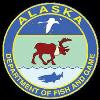








Alaska is known for glaciers, national parks, the vast wilderness, Northern lights, midnight sun, fishing industry, oil industry, and cruises.
Geography & DemographicsGovernment & LegislatureState SymbolsSports TeamsPopular Tourist AttractionsLocal FoodFamous PeopleFun Facts
Geography & Demographics
State Abbreviation AK
State Capital Juneau
State Size Total (Land + Water): 663,267 sq miles; Land Only: 571,951 sq miles
Number of Counties 27
Time Zone Alaska Time Zone, Hawaii-Aleutian Time Zone
Bordering States None
Highest Point Mt. Mckinley, 20,310 feet
Tallest Building Conoco-Phillips Building in Anchorage, 296 feet
Largest Stadium Sullivan Arena in Anchorage, capacity 6,290
National Parks Mt. Mckinley National Park and Preserve
Gates of the Arctic National Park
Glacier Bay National Park
Katmai National Park and Preserve
Kenai Fjords National Park
Kobuk Valley National Park
Lake Clark National Park
Wrangell-St. Elias National Park and Preserve
State Population (2020) 733,391
State Population Density 1.3 people / square mile
Area Codes 907
Top 5 Cities (2020 population) Anchorage (287,095)
Juneau (31,849)
Fairbanks (30,696)
Wasilla (11,099)
Sitka (8,405)
Government & Legislature
Statehood January 3, 1959
Electoral Votes 3
State Flag Alaska State Flag
State Quarter Issue Date August 25, 2008
State Bird Willow ptarmigan
State Fish Giant king salmon
State Flower Forget Me Not
State Fossil Wooly mammoth
State Gem Jade
State Insect Four spot skimmer dragonfly
State Land Mammal Moose
State Marine Mammal Bowhead whale
Nickname The Last Frontier
State Mineral Gold
State Motto North to the future
State Sport Dog mushing
State Tree Sitka spruce
Sports Teams
Major Sports Teams None
NCAA Division I Schools None
Table Tennis Clubs in Alaska
City Table Tennis Club
Fairbanks Fairbanks Interior Table Tennis
Popular Tourist Attractions
Alaska Native Heritage Center: Cultural center in Anchorage, Alaska.
Alaska SeaLife Center: Aquarium in Seward, Alaska.
Alaska Wildlife Conservation Center: Wildlife refuge in Anchorage, Alaska.
Alaska Zoo: Zoo in Anchorage, Alaska.
Alyeska Resort: Ski resort in Gridwood, Alaska.
Anchorage Museum: Museum in Anchorage, Alaska.
Arctic National Wildlife Refuge: National wildlife refuge in northeastern Alaska.
Chilkoot Trail: 33-mile trail from Dyea, Alaska, to Bennett, British Columbia, in Canada.
Chugach State Park: State park in Anchorage, Alaska.
Mt. Mckinley National Park: National park in the middle of Alaska.
Goldbelt Tram: Cable car station in Juneau, Alaska.
Icy Strait Point: Tourist attraction in Hoonah, Alaska.
Kenai Fjords National Park: National park on the Kenai Peninsula in southern Alaska.
Kincaid Park: Municipal park in Anchorage, Alaska.
Matanuska Glacier: Glacier in southern Alaska.
Mendenhall Glacier: Glacier about 12 miles from Juneau, Alaska.
Portage Glacier: Glacier on the Kenai Peninsula in southern Alaska.
Tongass National Forest: National forest in southeastern Alaska.
UNESCO Heritage Sites
Kluane / Wrangell-St. Elias / Glacier Bay / Tatshenshini-Alsek
Festivals and Events
Top festivals and events in Alaska. They are listed in approximate order of when they take place during the year.
Festival / Event When Location
Fur Rendezvous Festival February Anchorage
Iditarod Trail Sled Dog Race Early March From Anchorage to Nome
Alaska Folk Festival April Juneau
Kodiak Crab Festival Late May Kodiak
Sitka Summer Music Festival June Sitka
Midnight Sun Festival June Fairbanks
Girdwood Forest Fair July Girdwood
Alaska State Fair Late August to early September Palmer
Alaska Bald Eagle Festival November Haines
Anchorage International Film Festival December Anchorage
Popular Iconic Alaska Foods
Alaska is famous for the following foods:
Reindeer Sausage
King Crab Leg
Wild Alaskan Salmon
Wild Berries
Akutaq (Eskimo Ice Cream)
Sourdough
Miktuk
Oysters
Halibut
Spruce Tips
Berry Pie
Moose Stew
Fry Bread
Famous People Born In Alaska
Famous Actors And Actresses
Michelle Johnson
Annie Parisse
Darby Stanchfield
Alaska Fun Facts
The name “Alaska” was derived from the Aleut word “Alaxsxaq,” which means “mainland,” or literally, “object to which the action of the sea is directed.”
Outsiders first discovered Alaska in 1741 when Danish explorer Vitus Jonassen Bering sighted it on a voyage from Siberia.
Alaska is the only state that does not collect state sales tax or levy an individual state income tax
Alaska is home to North America’s highest peak, Mt. Mckinley (formerly known as Mount McKinley), at 20,320 feet.
The closest distance between mainland Alaska and mainland Russia is about 55 miles. In addition, the U.S.-owned Small Diomede and Russia-owned Big Diomede, both islands in the Bering Straits, are only about 2.5 miles apart.
Alaska has a longer coastline than all the other U.S. states combined. Alaska has 6,640 miles of coastline and, including islands, has 33,904 miles of shoreline.
Alaska has over 3 million lakes, of which 3,197 have an official name.
Alaska has over 130 volcanoes that have been active within the last two million years.
Juneau has no road access to the rest of the state. It is the only capital city in the United States accessible only by boat or plane.
Juneau is also the largest city in the United States, covering 3,108 square miles. Juneau is larger than the state of Rhode Island.
Nearly one-third of Alaska lies within the Arctic Circle.
